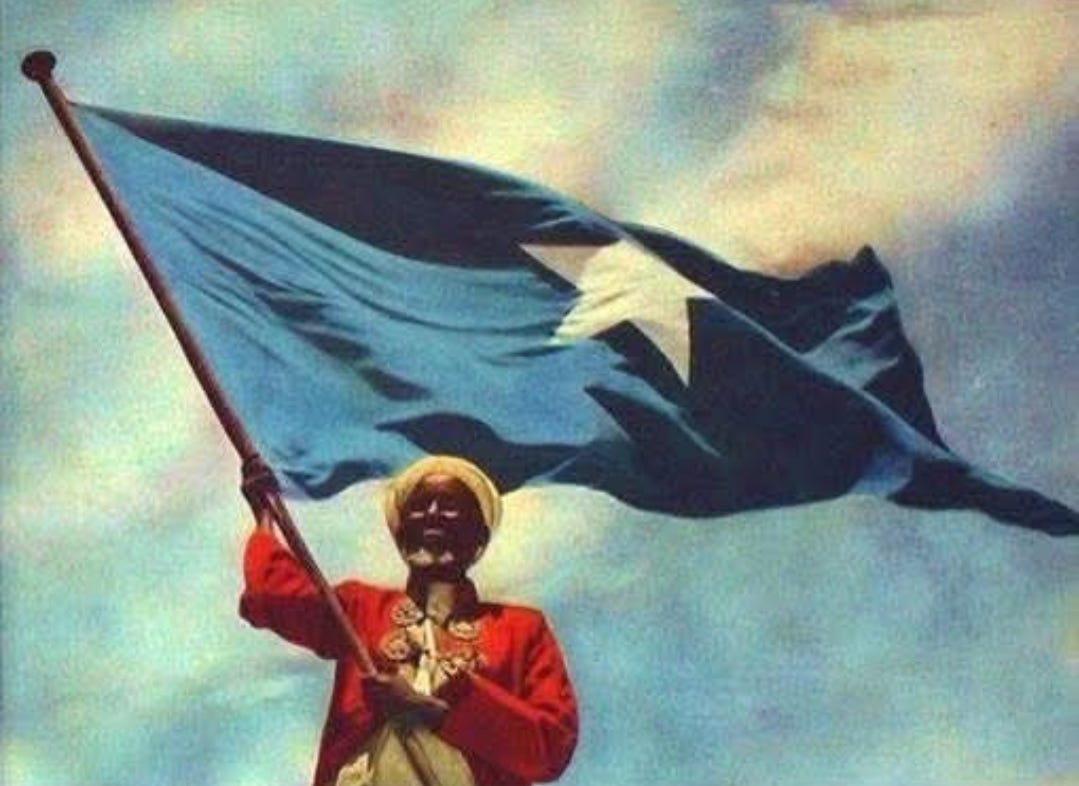In a striking archival image, a dignified figure, clad in traditional attire and a scarlet ceremonial tunic, raises aloft the blue flag of Somalia, its white five-pointed star billowing against a vast and clouded sky. This image, at once celebratory and solemn, encapsulates the paradoxes of Somali nationalism: its early hopes for unity and dignity, and the subsequent unraveling of the postcolonial project.
The Symbolism of the Flag: The Somali flag1, designed by Mohammed Awale Liban (see footnote comment) and first hoisted on October 12, 1954, was conceived as a visual embodiment of pan-Somali aspirations. The blue field, inspired by the United Nations flag, acknowledged the role of the UN in the trusteeship of Italian Somaliland. At its center, the five-pointed white star, referred to as the Star of Unity, signified the ambition to reunify all Somali-inhabited territories: British Somaliland, Italian Somaliland, French Somaliland (now Djibouti), the Somali region of Ethiopia (Ogaden), and the Northern Frontier District in Kenya.
This symbolic unity culminated briefly in 1960, when British and Italian Somaliland merged to form the Somali Republic. The image of the flag bearer, with his eyes directed skyward and the wind catching the emblem of a new republic, captures the euphoria and anti-colonial optimism that animated early independence discourse.
From Revolutionary Idealism to Postcolonial Fragmentation: Yet the ideological underpinnings of the flag must be read alongside the turbulent geopolitical history that followed. The pan-Somali dream was undermined by a combination of regional resistance, Cold War entanglements, and the vicissitudes of postcolonial governance. Djibouti opted for independent statehood in 1977 rather than union; Kenya resisted calls for cession of the NFD; and Ethiopia successfully repelled Somali forces during the Ogaden War (1977–78), a conflict that drained resources and exposed the fragility of Somali state institutions.
By the late 1980s, the Somali state, beset by authoritarianism under Siad Barre, economic decline, and clan-based factionalism, teetered on collapse. The civil war of the 1990s not only destroyed the central government but also fragmented the national imaginary the flag once sought to unify. In 1991, Somaliland declared independence and ceased to recognize the flag. Meanwhile, the Federal Government of Somalia, established in 2012, continues to claim the symbolism of unity amid ongoing contestation over sovereignty and territorial integrity.
The Politics of Memory and National Iconography: In this context, the image becomes more than a historical photograph, it is a visual text laden with contested meanings. The figure holding the flag may be interpreted as an allegory of precolonial dignity reasserting itself in the modern political form. Yet, in light of the fragmentation of the Somali Republic, the flag today often functions as a site of nostalgia and longing, especially among diasporic communities for whom it symbolizes continuity, cultural rootedness, and the hope of eventual restoration. The disjunction between the ideals inscribed in the flag and the political realities of the Horn of Africa speaks to a broader crisis of postcolonial nationhood. As scholars of nationalism have argued, national symbols are not static representations of unity but rather contested terrains where collective memory, identity, and political legitimacy are continuously negotiated.
After six and a half decades of independence, Somalia stands at a critical juncture. While its sovereignty was declared in 1960 with high aspirations for unity and progress, the ensuing decades have witnessed state collapse, protracted conflict, humanitarian crises, and fragmented governance. Yet, within this volatility lies resilience: the rise of digital remittances, community-led governance, and a vibrant diaspora signal adaptive potentials.
A scholarly stocktake demands recalibration beyond mere nationhood. Key questions emerge: What constitutes sovereignty in a federal yet fractured polity? How has informal governance shaped state legitimacy? Are current economic innovations, like mobile money, filling governance voids or entrenching inequality? Thus, Somalia’s 65-year journey requires not commemoration alone, but critical appraisal, a moment to rethink nation-building paradigms, confront structural dependency, and reimagine a political economy rooted in equity, decentralization, and local agency.
To conclude this post, the image of the Somali flag raised against the sky is both evocative and instructive. It encapsulates a pivotal moment in African decolonization, a vision of unity, dignity, and transnational solidarity. But it also reveals the limitations of symbolic politics when not grounded in durable institutions and inclusive governance. As Somalia continues to navigate its complex political landscape, the flag remains a potent yet ambivalent symbol, simultaneously a relic of unfulfilled promises and a beacon of aspirational nationhood.
Lately, I’ve been on the road, both literally and intellectually, sharing a few modest notes that, to my surprise, triggered a rare outbreak of thoughtful engagement. As I’ve hinted (repeatedly, perhaps ad nauseam), comments are welcome. After all, dialogue beats the solipsistic echo chamber of DMs, where insights go to die quietly. Let’s keep the conversation public, where it might accidentally benefit someone other than ourselves.





